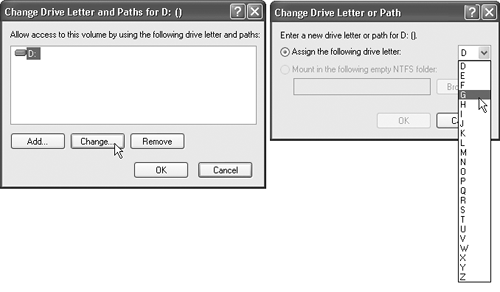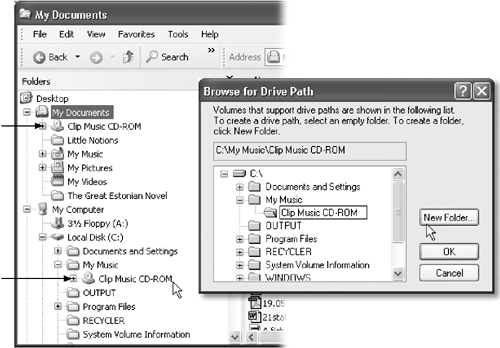16.5 Disk Management
| "Disk management" isn't just a cool, professional-sounding skill ”it's the name of yet another built-in Windows XP maintenance program, one that may be familiar to Windows 2000 veterans , but is completely new to people who are used to Windows Me and its predecessors. To open this technical database of information about your disks and drives , you can use any of three methods :
In any case, you arrive at the window shown in Figure 16-7. At first glance, it appears to be nothing more than a table of every disk (and partition of every disk) currently connected to your PC. In truth, the Disk Management window is a software toolkit that lets you operate on these drives, too. For example, Chapter 15 describes in detail how you can use this window to slice and dice the free space on your drives into new, combined "virtual disks" ( volumes ). Figure 16-7. The Drive Management window is part of the much bigger, much more technical entity known as the Computer Management console. You access it by clicking Disk Management (in the left-side pane). Then you can operate on your drives by right-clicking them. Don't miss the View menu, by the way, which lets you change either the top or the bottom display. For example, you can make them display all of your disks instead of your volumes (there's a difference). 16.5.1 Change a Drive Letter As you've probably noticed, Windows assigns a drive letter to each disk drive associated with your PC. The floppy disk drive is always A:, the primary internal hard drive is generally C:, and so on. Among other places, you see these letters in parentheses following the names of your drives, as when you choose Start Windows generally assigns these letters in the order that you install new drives to your system. You're not allowed to change the drive letter of your floppy drive or primary hard drive (usually the C: drive). You can, however, override the standard, unimaginative Windows letter assignments easily enough, as shown in Figure 16-8. Figure 16-8. Right-click a drive icon as shown in Figure 15-7. From the shortcut menu, choose Change Drive Letter and Paths. Left: In this dialog box, click Change. Right: Then choose a letter that hasn't already been assigned. Click OK, and then approve your action in the confirmation box. NOTE If Windows XP is currently using files on the disk whose drive letter you're trying to change, Disk Management might create the new drive letter assignment but leave the old one intact until the next time you restart the computer. This is an effort not to pull the rug out from under any open files. 16.5.2 Partition a New DriveThe vast majority of Windows PCs have only one hard drive, represented in the My Computer window as a single icon. Plenty of power users, however, delight in partitioning the hard drive ”dividing its surface so that it appears on the screen as two different icons with two different names. At that point, you can live like a king, enjoying the following advantages just like people who have two separate hard drives:
Unfortunately, partitioning a hard drive using the tools built into Windows XP requires first erasing the hard drive completely. And that, of course, involves copying all of your files and programs onto some kind of backup disk first ”and then copying them back onto the hard drive when the process is over. Ponder this compromise, weighing it against the advantages of partitioning. NOTE You can partition your hard drive without having to erase everything on it ”just not for free. Commercial programs like PartitionMagic ( http://www.powerquest.com ) create, resize, merge, and convert partitions without disturbing any of your files. The Disk Management program included with Windows XP, therefore, is best suited for creating new partitions on new or empty hard drives. Ditto for FDISK, a DOS utility that can also do the job (as described in Appendix A). In the Disk Management window, free space (suitable for turning into a partition of its own) shows up with a black bar and the label Unallocated. Figure 16-7, for example, depicts a brand new hard drive that hasn't yet been named or sliced up into partitions. The whole thing is still " unallocated ." To create a new partition, right-click one of these unallocated segments. From the shortcut menu, choose New Partition. A wizard appears, whose screens ask you:
When the wizard is through with you, it's safe to close the window. A quick look at your My Computer window will confirm that you now have new "disks" (actually partitions of the same disk), which you can use for different purposes. NOTE Partitioning and disk management can go even farther. You can resize your disk volumes, combine the space from multiple disks into one large volume, and perform other advanced stunts, as described in Chapter 15. 16.5.3 Turn a Drive into a FolderTalk about techie: Most people could go their entire lives without needing this feature, or even imagining that it exists. But Microsoft loves power users, and this one's for them. Using the Paths feature of Disk Management, you can actually turn a hard drive (or partition) into a folder on another hard drive (or partition). Each of these disks-disguised-as-folders is technically known as a mounted volume, junction point, or drive path . See Figure 16-9 for details. Figure 16-9. Left: Man, how many CD drives does this guy have? Just one. But through the miracle of mounted volumes, it's appearing in as many different folders as the owner likes. You could do the same thing with a hard drive ”make it appear as a folder icon on any other drive. Right: Here's how to do it: Designate an empty folder to be the receptacle ”a metaphysical portal ”for the drive's contents. This arrangement affords the following unique possibilities:
NOTE You can only create a mounted volume on an NTFS -formatted hard drive (see Section A.4). To bring about this arrangement, visit the Disk Management window, and then right-click the icon of the disk or partition that you want to turn into a mounted volume. From the shortcut menu, choose Change Drive Letter and Paths. In the Change Drive Letter and Paths dialog box, click Add; in the next dialog box, click Browse. Navigate to and select an empty folder ”the one that will represent the disk. (Click New Folder if you didn't create one in advance, as shown at right in Figure 16-9.) Finally, click OK. Once the deed is done, take time to note a few special characteristics of a mounted volume:
|
EAN: 2147483647
Pages: 230
 Control Panel
Control Panel